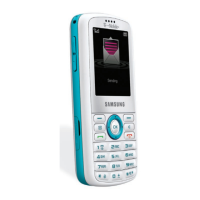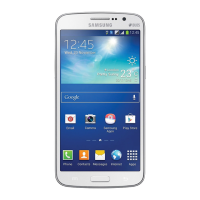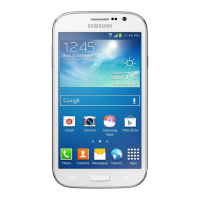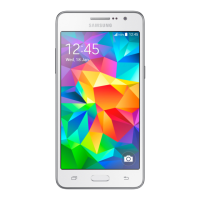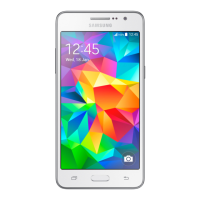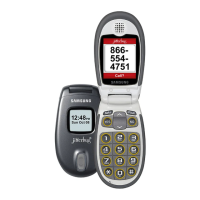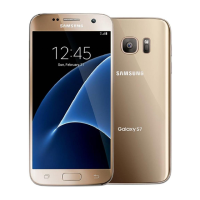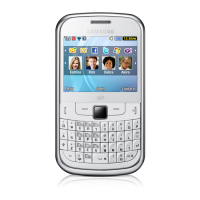Do you have a question about the Samsung Gravity Series and is the answer not in the manual?
Instructions for activating your phone and setting up voice mail.
Procedure for installing the SIM card into the phone.
Guidance on charging the phone's battery.
Overview of the phone's key features and capabilities.
Illustrations and descriptions of the phone's main external elements.
Explanation of the function of each key on the phone.
Description of the information displayed on the phone's screen.
List and explanation of symbols shown on the phone's display.
Settings for controlling the display and keypad backlight duration.
Instructions on how to make and end a call.
Procedures for recalling and managing recent call numbers.
How to adjust speaker and ring volumes.
Steps for answering or rejecting incoming calls.
Viewing lists of incoming, outgoing, and missed calls.
How to activate and deactivate vibration mode for notifications.
Managing incoming calls when already on another call.
Instructions for setting up and managing conference calls.
Navigating through the phone's menus using scroll keys.
Utilizing shortcut numbers for quick access to menu items.
Typing characters using the slideout QWERTY keyboard.
Switching between T9, ABC, Number, and Symbol input modes.
Overview of supported message types like text, picture, and email.
Explanation of icons indicating message status on screen.
Area displaying missed calls, picture messages, or voicemails.
Setup and options for sending and receiving email.
Creating and sending simple text messages with EMS features.
Creating and sending multimedia messages (MMS).
Storing and viewing received messages.
Saving messages to edit or send later.
Storing messages that have been sent.
Using pre-written text or picture templates for messages.
Creating and sending messages with voice recordings and photos.
Recording and sending voice notes via messages.
Accessing and managing voicemail messages.
Procedures for storing and managing contacts in the phonebook.
Searching for stored contacts by name or other criteria.
Creating and assigning pictures and ringtones to caller groups.
Modifying existing caller groups, including name, image, and ringtone.
Setting up and using speed dial entries for quick dialing.
Creating a virtual business card to share with recipients.
Adding and removing contacts to block unwanted callers.
Viewing contacts stored on SIM, Phone, or both.
Setting up and managing the Fixed Dial Number list.
Accessing and navigating the WAP browser for web access.
Scrolling through and selecting browser items.
Using different text input modes within the browser.
Accessing browser options menus for various actions.
Managing sounds, images, and viewing memory status.
Viewing, downloading, and setting sounds as ringtones.
Viewing photos and setting them as wallpaper or Picture ID.
Accessing and managing images downloaded from the web or memory card.
Viewing and managing video files stored on the phone or memory card.
Reviewing downloaded music and managing playback.
Downloading and playing Java applications (MIDlets) on the phone.
Adding music files, organizing playlists, and playing music.
Recording and sending voice notes as messages.
Editing images with effects, frames, and setting them as wallpaper.
Setting up to three alarms with customizable days, times, and tones.
Managing schedules, anniversaries, tasks, and miscellaneous events.
Creating and managing task lists with priority and status.
Creating notes to add to calendar events.
Using the phone as a basic calculator for arithmetic operations.
Calculating tip amounts based on bill and number of people.
Checking the time in different time zones around the world.
Performing conversions for currency, length, weight, volume, area, and temperature.
Setting and using a countdown timer.
Using the stopwatch function to measure time intervals.
Customizing the myFaves display, menu style, and contacts.
Customizing ringtones, volumes, and alert types for calls and messages.
Adjusting wallpaper, theme, font size, color, and backlight.
Configuring time, date, language, auto key lock, and USB mode.
Setting phone lock, application lock, and changing passwords.
Managing Bluetooth connectivity, visibility, and device profiles.
Configuring answer options, auto redial, call forwarding, and network selection.
Taking photos and sending them as messages or wallpapers.
Capturing photos and sending them to recipients.
Adjusting camera settings like shooting mode, size, timer, and effects.
Viewing, deleting, and managing photos.
Recording and saving video clips.
Information on RF energy exposure limits (SAR) and FCC guidelines.
Information on recycling Samsung mobile phones and accessories.
Safety instructions for the UL certified travel adapter.
FDA information on RF exposure from wireless phones.
Tips for safe wireless phone use while driving.
Precautions to avoid potential hearing loss from loud sounds.
Guidelines for using the phone in various environments and near other devices.
Details on what is covered, for how long, and what is excluded.
Instructions for activating your phone and setting up voice mail.
Procedure for installing the SIM card into the phone.
Guidance on charging the phone's battery.
Overview of the phone's key features and capabilities.
Illustrations and descriptions of the phone's main external elements.
Explanation of the function of each key on the phone.
Description of the information displayed on the phone's screen.
List and explanation of symbols shown on the phone's display.
Settings for controlling the display and keypad backlight duration.
Instructions on how to make and end a call.
Procedures for recalling and managing recent call numbers.
How to adjust speaker and ring volumes.
Steps for answering or rejecting incoming calls.
Viewing lists of incoming, outgoing, and missed calls.
How to activate and deactivate vibration mode for notifications.
Managing incoming calls when already on another call.
Instructions for setting up and managing conference calls.
Navigating through the phone's menus using scroll keys.
Utilizing shortcut numbers for quick access to menu items.
Typing characters using the slideout QWERTY keyboard.
Switching between T9, ABC, Number, and Symbol input modes.
Overview of supported message types like text, picture, and email.
Explanation of icons indicating message status on screen.
Area displaying missed calls, picture messages, or voicemails.
Setup and options for sending and receiving email.
Creating and sending simple text messages with EMS features.
Creating and sending multimedia messages (MMS).
Storing and viewing received messages.
Saving messages to edit or send later.
Storing messages that have been sent.
Using pre-written text or picture templates for messages.
Creating and sending messages with voice recordings and photos.
Recording and sending voice notes via messages.
Accessing and managing voicemail messages.
Procedures for storing and managing contacts in the phonebook.
Searching for stored contacts by name or other criteria.
Creating and assigning pictures and ringtones to caller groups.
Modifying existing caller groups, including name, image, and ringtone.
Setting up and using speed dial entries for quick dialing.
Creating a virtual business card to share with recipients.
Adding and removing contacts to block unwanted callers.
Viewing contacts stored on SIM, Phone, or both.
Setting up and managing the Fixed Dial Number list.
Accessing and navigating the WAP browser for web access.
Scrolling through and selecting browser items.
Using different text input modes within the browser.
Accessing browser options menus for various actions.
Managing sounds, images, and viewing memory status.
Viewing, downloading, and setting sounds as ringtones.
Viewing photos and setting them as wallpaper or Picture ID.
Accessing and managing images downloaded from the web or memory card.
Viewing and managing video files stored on the phone or memory card.
Reviewing downloaded music and managing playback.
Downloading and playing Java applications (MIDlets) on the phone.
Adding music files, organizing playlists, and playing music.
Recording and sending voice notes as messages.
Editing images with effects, frames, and setting them as wallpaper.
Setting up to three alarms with customizable days, times, and tones.
Managing schedules, anniversaries, tasks, and miscellaneous events.
Creating and managing task lists with priority and status.
Creating notes to add to calendar events.
Using the phone as a basic calculator for arithmetic operations.
Calculating tip amounts based on bill and number of people.
Checking the time in different time zones around the world.
Performing conversions for currency, length, weight, volume, area, and temperature.
Setting and using a countdown timer.
Using the stopwatch function to measure time intervals.
Customizing the myFaves display, menu style, and contacts.
Customizing ringtones, volumes, and alert types for calls and messages.
Adjusting wallpaper, theme, font size, color, and backlight.
Configuring time, date, language, auto key lock, and USB mode.
Setting phone lock, application lock, and changing passwords.
Managing Bluetooth connectivity, visibility, and device profiles.
Configuring answer options, auto redial, call forwarding, and network selection.
Taking photos and sending them as messages or wallpapers.
Capturing photos and sending them to recipients.
Adjusting camera settings like shooting mode, size, timer, and effects.
Viewing, deleting, and managing photos.
Recording and saving video clips.
Information on RF energy exposure limits (SAR) and FCC guidelines.
Information on recycling Samsung mobile phones and accessories.
Safety instructions for the UL certified travel adapter.
FDA information on RF exposure from wireless phones.
Tips for safe wireless phone use while driving.
Precautions to avoid potential hearing loss from loud sounds.
Guidelines for using the phone in various environments and near other devices.
Details on what is covered, for how long, and what is excluded.
| Form Factor | Slider |
|---|---|
| Operating System | Proprietary |
| Keypad | QWERTY |
| Data | GPRS, EDGE |
| Network | GSM 850 / 900 / 1800 / 1900 |
| Talk time | Up to 5 hours |
| Display | TFT |
| Battery | Li-Ion |


